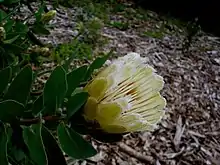| Protea mundii | |
|---|---|
 | |
| Scientific classification | |
| Kingdom: | Plantae |
| Clade: | Tracheophytes |
| Clade: | Angiosperms |
| Clade: | Eudicots |
| Order: | Proteales |
| Family: | Proteaceae |
| Genus: | Protea |
| Species: | P. mundii |
| Binomial name | |
| Protea mundii Klotzsch | |
Protea mundii, the forest sugarbush, is a flowering shrub native to the Cape Provinces of South Africa,[2] growing in forest margins at 200 to 1,300 m (660 to 4,270 ft) elevation. It grows to a height of 8 m (26 ft). The plant has white to ivory flowers, which are attractive to bees, butterflies and/or birds.[3] The specific name commemorates Johannes Ludwig Leopold Mund, a German natural history collector who was active in the Cape until 1831.
Protea mundii is cultivated as a garden plant.[4]
References
- ↑ Rebelo, A.G.; Mtshali, H.; von Staden, L. (2020). "Protea mundii". IUCN Red List of Threatened Species. 2020: e.T113210891A185535233. doi:10.2305/IUCN.UK.2020-3.RLTS.T113210891A185535233.en. Retrieved 18 November 2021.
- ↑ "Protea mundii". Germplasm Resources Information Network. Agricultural Research Service, United States Department of Agriculture. Retrieved 2020-02-02.
- ↑ "White Water Sugarbushes". www.proteaatlas.org.za. Retrieved 2017-08-02.
- ↑ University of Connecticut
This article is issued from Wikipedia. The text is licensed under Creative Commons - Attribution - Sharealike. Additional terms may apply for the media files.
